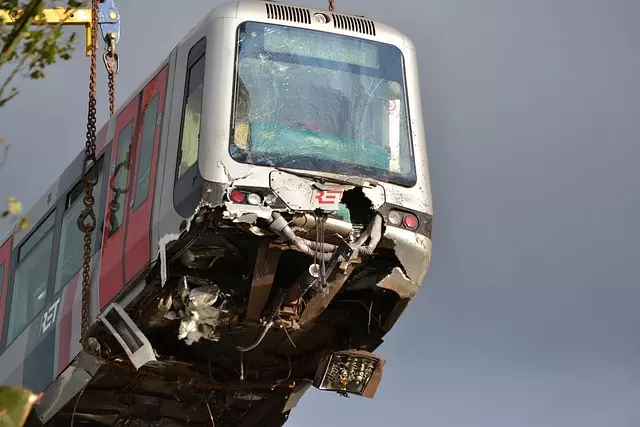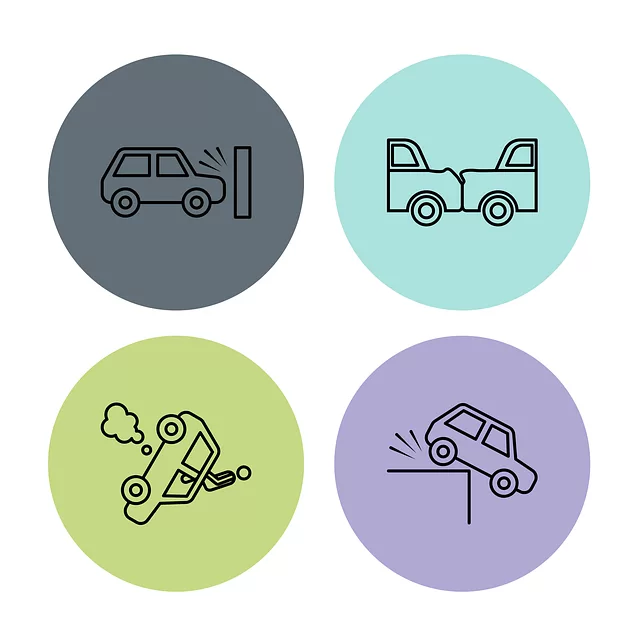Distracted Driving & Car Crashes in NYC: Navigating Legal Implications

Distracted driving car crashes in New York City are on the rise, leading to a surge in lawsuits and…….
In the bustling metropolis of New York City (NYC), a growing concern has emerged at the intersection of technology, mobility, and public safety: distracted driving crashes. This phenomenon, characterized by drivers engaging in non-driving activities while behind the wheel, has significant implications for NYC’s roads and its residents. With a dense population, complex traffic patterns, and a culture that embraces 24/7 connectivity, understanding and addressing distracted driving is crucial to ensuring safer streets in this iconic city. This article aims to delve into the intricacies of distracted driving car crashes in NYC, exploring their causes, impacts, and potential solutions, offering valuable insights for policymakers, urban planners, and citizens alike.
Distracted driving refers to the act of operating a motor vehicle while engaged in any activity that diverts attention from safe driving practices. This includes various behaviors such as using mobile phones, eating, drinking, adjusting the radio or navigation system, interacting with passengers, or any other task unrelated to driving. In NYC, where traffic congestion and pedestrian-heavy environments are common, distracted driving can have severe consequences due to the unique challenges posed by urban driving.
The issue of distracted driving has gained prominence in recent years, mirroring a global trend driven by increasing mobile technology adoption. While it is not a new phenomenon, the rise of smartphone usage has exacerbated its impact. In NYC, the high density of vehicles and pedestrians makes it particularly vulnerable to distracted driving incidents. According to the New York State Department of Motor Vehicles (DMV), accidents caused by driver inattention have been on the rise, underscoring the urgent need for comprehensive strategies to mitigate these crashes.
Distracted driving car crashes are a sub-set of a broader safety concern known as driver distraction. This category includes various forms of distractions, not limited to mobile phones, and encompasses both manual and cognitive aspects. In NYC, addressing distracted driving requires an integrated approach that considers the unique urban driving environment, cultural norms, and regulatory frameworks. Understanding these factors is essential for implementing effective countermeasures.
The issue of distracted driving is a global concern, with every region facing its unique challenges. NYC’s experience mirrors those of many metropolitan areas worldwide that struggle with the increasing rates of driver distraction. According to a study by the World Health Organization (WHO), road traffic crashes involving distracted drivers have significant global implications, resulting in hundreds of thousands of deaths annually. This highlights the need for harmonized strategies to tackle this issue across borders.
Mobile Phone Usage: The proliferation of smartphones has been a primary driver of distracted driving globally. In NYC, a survey by the New York City Police Department (NYPD) revealed that mobile phone use while driving is a leading cause of accidents involving driver inattention.
Social Media and Apps: The rise of social media and location-based apps has further complicated the issue. Drivers may engage in app interactions, such as text messaging or navigation, during their commute, increasing the risk of crashes.
Younger Drivers: Research suggests that younger drivers are more susceptible to distracted driving. In NYC, where a significant portion of the driving population is comprised of millennials and Gen Z, this trend poses unique challenges for traffic safety authorities.
Different regions have witnessed varying trends in distracted driving patterns:
| Region | Key Trends | Examples |
|---|---|---|
| North America | High mobile phone usage, particularly among younger drivers | Texting while driving is more prevalent in the US than in many other countries |
| Europe | Strict regulations and public awareness campaigns | Countries like Germany have implemented severe penalties for handheld device use while driving |
| Asia Pacific | Increasing smartphone penetration, leading to higher app-based distractions | Japan has seen a rise in accidents related to in-car navigation systems |
| Middle East | Cultural norms encouraging multi-tasking while driving | Some countries promote the use of hands-free devices, but enforcement remains inconsistent |
The economic implications of distracted driving car crashes are far-reaching. In NYC, these incidents have significant costs associated with them:
Medical Expenses: Victims of distracted driving crashes often require extensive medical treatment, leading to increased healthcare spending.
Insurance Claims: Insurers bear the brunt of compensation for injuries and property damage caused by distracted drivers. This translates to higher premiums for both individuals and insurance companies.
Lost Productivity: Crashes disrupt daily life, resulting in lost work hours and reduced productivity for both drivers and emergency services personnel.
Distracted driving crashes can impact NYC’s overall economic health:
Tourism and Hospitality: A perception of unsafe streets may deter tourists, affecting the city’s thriving tourism industry.
Business Operations: Increased traffic congestion due to accidents can delay emergency services and affect business operations, particularly in sectors reliant on timely deliveries.
Public Finances: The economic burden of crashes extends to public funds, which are used for medical treatment, insurance subsidies, and road repairs.
Mobile Phone Use: Sending texts, making calls, or using social media apps while driving is a leading cause of distraction.
Adjusting In-Car Systems: Navigation, radio, or climate control settings can divert drivers’ attention from the road.
Eating and Drinking: Consuming food or beverages during driving can impair reaction time and visual focus.
Passenger Distractions: Interacting with passengers, especially younger children, can distract drivers, particularly in unfamiliar surroundings.
Increased Crash Rates: NYC has witnessed a rise in accidents attributed to driver inattention, leading to injuries and fatalities.
Longer Response Times: Emergency services may face delays due to distracted drivers, impacting the effectiveness of response times during critical incidents.
Legal Implications: Drivers found guilty of distracted driving can face fines, license suspensions, or even jail time, depending on the severity of the incident.
While New York State has laws prohibiting the use of handheld devices while driving, enforcement remains a challenge. The NYPD and local law enforcement agencies should focus on targeted campaigns and increased patrols to deter distracted driving. Strict penalties and public awareness campaigns can serve as powerful dissuasants.
Media Campaigns: NYC’s transportation authorities can launch multimedia campaigns highlighting the dangers of distracted driving, using platforms like social media, billboards, and TV ads to reach a wide audience.
Community Engagement: Partnering with schools, community centers, and youth organizations can help educate younger drivers about responsible driving practices.
In-Vehicle Reminders: Encouraging the use of in-car technology that reminds drivers to “focus on the road” or provides audio cues when handheld device use is detected can be effective.
Driver Monitoring Systems: Advanced driver assistance systems (ADAS) equipped with driver monitoring features can detect signs of distraction and alert drivers or take corrective actions, such as gentle steering corrections.
App-Blocking Features: Smartphone manufacturers and carriers can collaborate to develop app-blocking tools that prevent the use of specific apps while driving, ensuring drivers remain focused on the road.
Connected Vehicle Technology: Integrating connected vehicle technology can enable real-time communication between vehicles and infrastructure, enhancing safety by detecting and warning about potential hazards, including distracted drivers.
Pedestrian-Friendly Zones: Designing streets with dedicated pedestrian spaces and reducing traffic speeds in congested areas can minimize the risk of accidents involving pedestrians and distracted drivers.
Public Transportation Enhancements: Investing in efficient public transit systems can reduce vehicle mileage, thereby lowering the overall number of vehicles on the road and potentially decreasing distracted driving incidents.
London’s successful implementation of congestion charges and low emission zones has led to a significant reduction in traffic congestion, resulting in calmer roads and potentially lower rates of distracted driving. Similar initiatives in NYC could encourage more efficient transportation choices and reduce the overall number of vehicles on the road.
Sweden’s Vision Zero policy aims to eliminate all traffic-related deaths and serious injuries. This approach has led to a comprehensive rethinking of urban mobility, with infrastructure designs prioritizing safety, strict enforcement, and public awareness campaigns that emphasize shared responsibility for road safety. NYC could adapt these principles to create a culture of safe driving practices.
Distracted driving car crashes in New York City are a complex issue requiring a multi-faceted approach. By understanding the causes, consequences, and global trends, NYC can develop robust strategies to address this challenge. A combination of stricter enforcement, public education, technological interventions, and urban planning innovations is crucial for creating safer streets. As technology continues to evolve, staying ahead of emerging distractions will be essential in ensuring that NYC’s roads remain among the safest in the world.
This analysis provides a comprehensive framework for policymakers and urban planners to navigate the complex landscape of distracted driving, ultimately contributing to the well-being and safety of New York City residents and visitors alike.

Distracted driving car crashes in New York City are on the rise, leading to a surge in lawsuits and…….

Distracted driving has become a leading cause of car crashes in New York City, resulting in injuries…….

Distracted driving is a growing concern in New York City, leading to a spike in cyclist accidents du…….

Distracted driving laws in New York City, including The Bronx, target growing car crash issues cause…….

Distracted driving, particularly mobile device usage like texting while driving, is a growing concer…….

In bustling New York City, including Staten Island, slip and fall incidents and distracted driving c…….

Birth injuries, often caused by preventable complications during labor, demand parental vigilance. C…….

Distracted driving is a growing concern in New York City, with heavy traffic and mobile devices cont…….

Distracted driving, fueled by mobile device usage, is a leading cause of driver inattention in New Y…….

In New York City, distracted driving significantly contributes to soft tissue injuries in car crashe…….